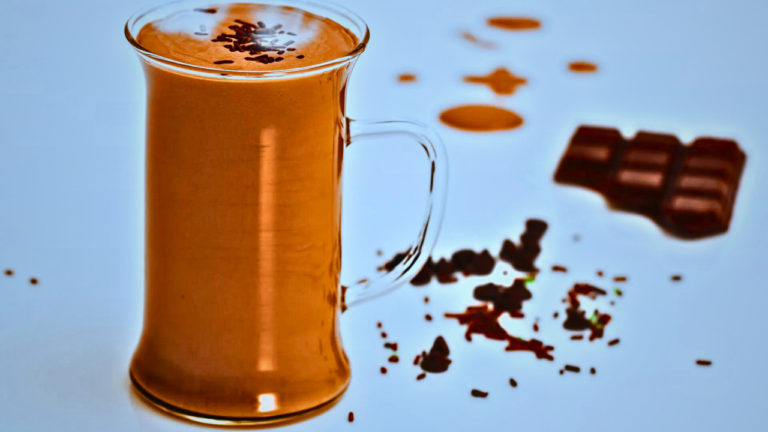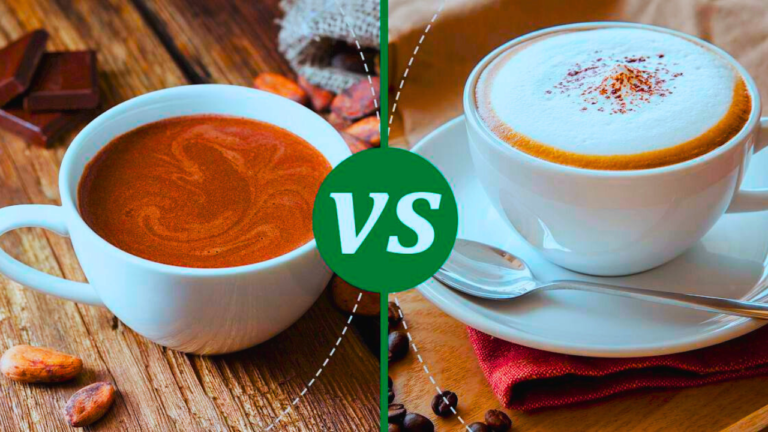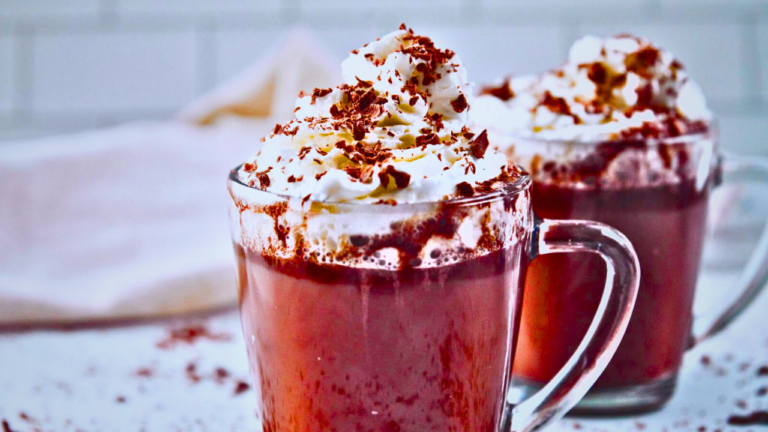How Do You Make Hot Chocolate Without Milk?
Hot chocolate, a quintessential comfort beverage, is traditionally associated with milk as one of its core ingredients. However, understanding that various reasons, such as dietary limitations and lifestyle choices, might make it necessary to create a dairy-free version, this article talks about how traditional hot chocolate can be reinvented without the use of milk. Renowned for its warmth and creamy texture, hot chocolate might seem impossible to recreate without dairy, but as we shall see, it’s entirely achievable and might even introduce you to new flavors and textures you hadn’t previously imagined.
“Creativity is the sole heart of gastronomy. Learning to make hot chocolate without milk is a beautiful testament to the versatility of cooking.”
Our exploration begins with a look at the versatility of dairy-free alternatives, the effect of such substitutions on the taste and texture of hot chocolate, and the best types of cocoa powder for dairy-free hot chocolate.
- Understand the available dairy-free alternatives
- Analyzing the effect of milk substitution on taste and texture
- Identifying the best type of cocoa powder for dairy-free hot chocolate
- Mastering techniques for a creamy texture without milk
- Discovering additional ingredients to jazz up the flavor
Building upon this, we delve into techniques to ensure a rich and creamy texture sans milk and round off with a selection of additional flavor-enhancing ingredients.
What are the best dairy-free alternatives for milk in hot chocolate?
The answer to this query might lie in a broad array of alternatives that have been embraced by those seeking to enjoy a steaming cup of hot chocolate without the use of milk. These substitutions exhibit diverse properties, mirroring the rich tapestry of flavors found in hot chocolate.
- Almond Milk: Emerging as a popular option, almond milk imparts a lightly sweet and nutty hint to the hot chocolate. For individuals keen on a creamier texture, unsweetened vanilla almond milk can serve as an excellent choice.
- Soy Milk: With its creamy texture and neutral taste, soy milk stands out by mimicking the consistency of full-fat milk. This smooth and luscious dairy substitute amplifies the creamy quality of hot chocolate.
- Coconut Milk: Coconut milk offers a unique blend of rich, creamy texture and a slight tropical note. Integrate full-fat coconut milk into the mix for a thick consistency hinting at a hint of exoticism.
- Cashew Milk: Cashew milk plays a dual role, introducing a creamy consistency while lending an understated sweet, nutty note that complements the taste structure of hot chocolate. Especially when made at home, it can offer a luxurious richness.
- Oat Milk: Oat milk boasts a neutral taste with a thick texture, akin to that of whole milk. Couple this with its inherent ability to froth well, and you have an ingredient capable of creating a foamy top layer on your hot chocolate.
With these options, creating a dairy-free treat is within grasp. Understanding your taste preferences will help you choose the most suitable alternative. Do not be restricted by tradition; rather, let your taste buds explore the myriad of options available, marrying flavor with health considerations.
How does the substitution of milk affect the taste and texture of hot chocolate?
The substitution of milk in a hot chocolate recipe with a dairy-free alternative drastically influences both the taste and texture of the final product. It’s fascinating to understand the impacts of these alterations and how they, in fact, can result in a delightful cup of hot chocolate catering to the dietary requirements and preferences of the individual.
The taste of hot chocolate primarily depends on the selected alternative to milk. Noteworthy is the fact that every dairy-free milk substitute carries a unique flavor profile. Almond milk, for instance, imbues the hot chocolate with a slightly nutty undertone, whereas soy milk imparts a somewhat creamier and thicker consistency similar to the original dairy version. As for the coconut milk variant, it gifts the hot chocolate with a delightful trace of tropical flavor. Therefore, the taste is predominantly subjected to and altered by the type of dairy-free milk used.
Texture-wise, the changes can be equally significant. Fundamentally, the texture of hot chocolate is a result of the constituents present in the milk or its substitute. Unlike regular milk, which brings a high content of fat and proteins to the equation, most dairy-free variations are comparably lower in these terms, thereby influencing the final texture. For example, almond milk might create a thinner beverage, whereas coconut milk could lead to a richer one thanks to its higher fat content.
In essence, both the taste and texture of dairy-free hot chocolate can be remarkably different from its classic, milk-rooted counterpart. However, these alterations are not necessarily negative. It allows consumers to enjoy a spectrum of flavors and textures, thereby creating a personalized hot chocolate experience that is both satisfying and health-centric.
Nevertheless, to obtain an ideal balance between flavor and texture, it’s vital to experiment with different non-dairy alternatives and neutral-tasting sweeteners. With the right approach and effort, it’s possible to create a cup of dairy-free hot chocolate that rivals and even surpasses its traditional equivalent in terms of creaminess, taste, and overall satisfaction.
Read also: Can You Drink Hot Chocolate With Braces?
What type of cocoa powder is best used for dairy-free hot chocolate?
When stepping into the realm of dairy-free hot chocolate, the selection of the right cocoa powder plays a critical role in achieving the desired result. It is, after all, the backbone of this delectable beverage. Different types impart varying depths of flavor and richness to the hot chocolate; hence, understanding their unique profiles can elevate your dairy-free hot chocolate experience to uncharted heights.
Unsweetened natural cocoa powder, the purest form of cocoa powder, is commonly favored. Distinctively bitter in its raw form, it imparts a profound, earthy chocolate flavor to the beverage. This type, devoid of any additives, can strike a balance with the sweetness of the alternative milk or sweetener used, preventing the hot chocolate from becoming overly sweet. This unsweetened gem also complements a wide array of additional flavor enhancers, such as spices or extracts, thereby offering a malleable base for the beverage.
In contrast, Dutch-processed cocoa powder, though less used, exhibits a pleasant, milder flavor. Treated with an alkalizing agent, it exhibits a darker color and a smoother, less acidic taste. This makes it an option for those who prefer a more subdued chocolate flavor, while also ensuring the hot chocolate is not excessively rich or overwhelming to the palate.
It’s worth noting that, in the absence of dairy products, the cocoa powder selected must shoulder a greater portion of the hot beverage’s flavor profile. This makes the decision all the more pivotal to the creation of a smoothly-textured, richly-flavored dairy-free hot chocolate.
Moving on, let’s delve into some technicalities when using cocoa powder. To avoid lump formation in the hot chocolate, it is suggested to mix the cocoa powder with a small quantity of warm liquid—be it water or your chosen dairy substitute—to create a paste. Gradually adding the remaining liquid while stirring continuously will yield a smooth, lump-free beverage. This somewhat tedious yet vital process ensures a silky, homogeneous hot chocolate.
Thus, the selection and judicious utilization of the cocoa powder are defining factors in creating an impressive dairy-free hot chocolate that can rival, if not surpass, its dairy-filled counterparts. Undoubtedly, savoring a mug of this luscious beverage, created with careful precision, can turn winter nights into cozy, delightful affairs.
Are there specific techniques or steps to ensure a rich and creamy texture without milk?
In the world of cocoa lovers, one might think that compromising on the creamy texture of hot chocolate is an unavoidable consequence of embracing dairy-free alternatives. However, with a judicious combination of techniques and accuracy in the selection of ingredients, it is indeed possible to prepare a hot chocolate without milk that is equally rich and indulges your desire for smooth creaminess.
“thy will be done, oh chocolatier, that no drop of liquid gold, dark or white, shall disappoint any connoisseur seeking the sweet reward of the cocoa beans”
Begin with the utmost care in the choice of cocoa powder. A superior-quality cocoa powder, being unsweetened, provides the flexibility to balance the cocoa content with the sweetening element of your choice. The intense cocoa flavor remains uncompromised even in the absence of milk.
- Blending carefully: Dairy-free hot chocolate requires a stirring method that mimics the velvety texture of milk-based hot chocolate. The technique of gradually incorporating the heated dairy-free milk alternative to the cocoa powder while continuously stirring contributes to a smooth and creamy outcome.
- Utilizing thickening agents: introducing a natural thickening agent such as cornstarch can contribute to enhancing the thickness and richness of your hot chocolate. Use a teaspoon of cornstarch for every two cups of liquid.
- Employing sweeteners: This is where your creative culinary spirit can come into play. From cane sugar to coconut sugar, from agave nectar to honey, finding the right sweetener that not only complements the cocoa but also contributes to the overall thickness and creaminess of your hot chocolate can be a game-changer.
Following the above techniques, one might wonder if the journey towards dairy-free hot chocolate perfection ends here. If the culinary Greek god of cocoa, Miltiades, Konstantinos, were to hear such a premise, he might respond with a twinkle in his eye, “For those in pursuit of the ultimate cocoa indulgence, the journey doth never end. There are always new realms to explore within the aromatic embrace of the sacred cocoa pod.”
What are some additional ingredients to enhance the flavor of dairy-free hot chocolate?
Dairy-free hot chocolate, much like its traditional counterpart, offers a canvas for culinary exploration. Beyond the basic ingredients of cocoa powder and a dairy-free milk alternative, a plethora of additional enhancements can provide depth of flavor, a touch of complexity, and a delightful surprise for the palate. Some of these flavor enhancers particularly work well with the unique profile of dairy-free hot chocolate, intertwining with its inherent properties to create a truly memorable beverage experience.
- Cinnamon: Ideal for adding a warm, spicy note, cinnamon is a timeless addition that enhances the overall flavor of the hot chocolate, imparting a subtly sweet and fragrant profile that beautifully complements the chocolate’s bitterness.
- Vanilla Extract: By adding a hint of vanilla, hot chocolate is elevated with an unbeatable richness and aroma. This underrated ingredient can add an essence of satisfying depth to the drink.
- Chili Powder: For those who enjoy a bit of adventure in their cup, chili powder can introduce a delightful heat that contrasts exquisitely with the rich sweetness of the chocolate. The Aztecs pioneered this combination, and it’s proven to be a winner for thousands of years.
- Sweeteners: Sugar is often the default choice, but alternatives like maple syrup, agave nectar, or coconut sugar are increasingly popular and can offer nuanced flavors while sweetening your beverage.
- Sea Salt: Using a little sea salt in your hot chocolate can surprisingly boost its sweetness rather than make it salty, adding a depth that balances the flavors wonderfully.
No set rules extend to the addition of these extra flavors; personal preference presides. Therefore, we encourage experimenting with combinations and quantities to find the perfect blend that enhances the dairy-free hot chocolate experience for your individual taste.
Do these additions suffice to replace the unique properties of milk in traditional hot chocolate? Absolutely. In fact, the versatility of dairy-free hot chocolate goes above and beyond to present a diverse flavor palette. From warm and comforting to bold and exciting, the possibilities of flavor augmentation using these additions are endless in dairy-free hot chocolate, revealing that milk or no milk, an invigorating and indulgent cup of hot chocolate awaits every enthusiast.
Read also: Is Tim Hortons Hot Chocolate Caffeine Free?
Conclusion
Undoubtedly, the voyage to create a delectable cup of hot chocolate without the ubiquitous ingredient, milk, can be challenging. This exploration whisks one into the captivating world of diverse flavors and revolutionary culinary techniques. However, with a keen and adventurous palate as well as an open mind, the end result can be more rewarding than initially envisioned.
While dairy-free alternatives may not replicate the exact taste and texture that milk confers, they bring their unique charm to the table. The alternative shines through its undertones of nuttiness or creaminess, each complementing the rich cocoa in a distinct manner. The choice of these alternatives can be as wide as the culinary world itself, offering a selection of coconut milk, almond milk, soy milk, and more. Thus, it’s safe to say that such alternatives do not simply replace milk but revolutionize the very essence of hot chocolate.
When it comes to cocoa powder, the ideal preference would lean towards unsweetened, pure cocoa. This selection hinges on the ultimate taste and richness of the hot chocolate. It remains essential to remember that the quality of cocoa, much like the traditional saying “the heart of the matter,” is the key.
It’s also worth noting that the journey to creamy, dairy-free hot chocolate isn’t solely dependent on these alternatives; it’s also about the use of smart, unconventional techniques. For example, blending the hot beverage instead of simply stirring can lead to the optimal marriage of cocoa and the chosen alternative, giving it a tantalizingly smooth texture. In addition, heating the mixture at low temperatures for prolonged periods of time can refine the overall outcome.
While the hot chocolate itself is the star of the show, additional ingredients, like sugar, vanilla extract, or spices like cinnamon, can serve as supportive players that enhance the overall excellence of the performance. Once again, there are no stringent rules or boundaries limiting the creativity in adding these supplementary ingredients.
To crystallize, creating hot chocolate without milk is far from a compromise—in fact, it’s an opportunity to rethink tradition and to carve out fresh culinary avenues. With the right balance of creativity and mindfulness, a new kind of hot chocolate—aromatic, creamy, and satisfying—is within reach. So, be bold, experiment, and enjoy the euphoria of sipping on a hot beverage that’s made exactly to your liking, sans dairy, and bursting with flavor.
FAQs
Is hot chocolate without milk healthy?
This depends primarily on the ingredients used. If natural sweeteners, high-quality cocoa powder, and healthful milk alternatives are employed, dairy-free hot chocolate can indeed be a healthy beverage choice.
Can water be used as a substitute for milk?
Yes, water can act as a simple and readily available substitution. However, be prepared that using water alone may result in a less creamy and full-bodied hot chocolate.
Can hot chocolate be made without sweeteners?
Yes, it’s possible, especially if you’re using a naturally sweet milk substitute or you prefer a bitter, dark chocolate flavor. However, adding sweeteners enhances the flavor and makes the hot chocolate taste more traditional.
What can be added to dairy-free hot chocolate for extra flavor?
One can add a variety of spices, such as cinnamon, nutmeg, or chili powder; extracts such as vanilla or peppermint; or even a pinch of sea salt, to enhance the flavor of the hot chocolate.
Can I use dark chocolate instead of cocoa powder?
Yes, you can melt dark chocolate and combine it with your milk substitute. Keep in mind that dark chocolate can be more bitter than cocoa powder, so adjust your sweeteners accordingly.
Does dairy-free hot chocolate have a different nutritional profile?
The nutritional profile of dairy-free hot chocolate would depend on the milk substitute and other ingredients used. Many milk alternatives can offer similar or even higher nutritional benefits than dairy milk when fortified with vitamins and minerals.
Is dairy-free hot chocolate suitable for vegans?
Assuming all ingredients used, including the cocoa powder, sweeteners, and substitute milk, are plant-based and free of animal-derived components, then yes, dairy-free hot chocolate can indeed be a suitable treat for those following a vegan diet.
How can I make my dairy-free hot chocolate creamier without milk?
You can opt for creamy milk substitutes like coconut milk or cashew milk. Another trick is to add a small amount of coconut oil or a spoonful of nut butter. These options help to achieve a creamier texture.
Is lactose-free milk a good option for dairy-free hot chocolate?
While lactose-free milk is an excellent option for those who are lactose intolerant, it’s not technically dairy-free as it’s still derived from cow’s milk. For a truly dairy-free hot chocolate, you will need to use a plant-based milk substitute.
How long does it take to prepare dairy-free hot chocolate?
The preparation of dairy-free hot chocolate is not significantly time-consuming. On average, the process could take anywhere from 5 to 15 minutes, depending on the complexity of the recipe and the ingredients used.

Welcome to the delightful world of “Hot Chocolate Brew,” where the art of crafting and savoring hot chocolate takes center stage. I am Smith Karen, your guide on this indulgent journey through the rich and velvety universe of hot chocolate. As a passionate enthusiast of this comforting elixir, I am thrilled to share my insights, recipes, and experiences with fellow connoisseurs and those eager to explore the diverse realm of hot chocolate.
At “Hot Chocolate Brew,” we believe that a steaming cup of cocoa has the power to warm not just your body but also your soul. Whether you’re a seasoned hot chocolate aficionado or a newcomer to the world of cocoa delights, our aim is to provide you with a delectable blend of inspiration, knowledge, and mouthwatering recipes.
Join me in uncovering the secrets behind the perfect cup of hot chocolate, from selecting the finest ingredients to experimenting with unique flavor combinations. From classic recipes that evoke nostalgic warmth to innovative twists that will surprise your taste buds, “Hot Chocolate Brew” is your go-to resource for all things cocoa-related.
Prepare to embark on a journey of indulgence, as we explore the nuances of this timeless beverage together. Get ready to elevate your hot chocolate experience and make every sip a moment of pure, chocolaty bliss. Cheers to the joyous world of “Hot Chocolate Brew”!






